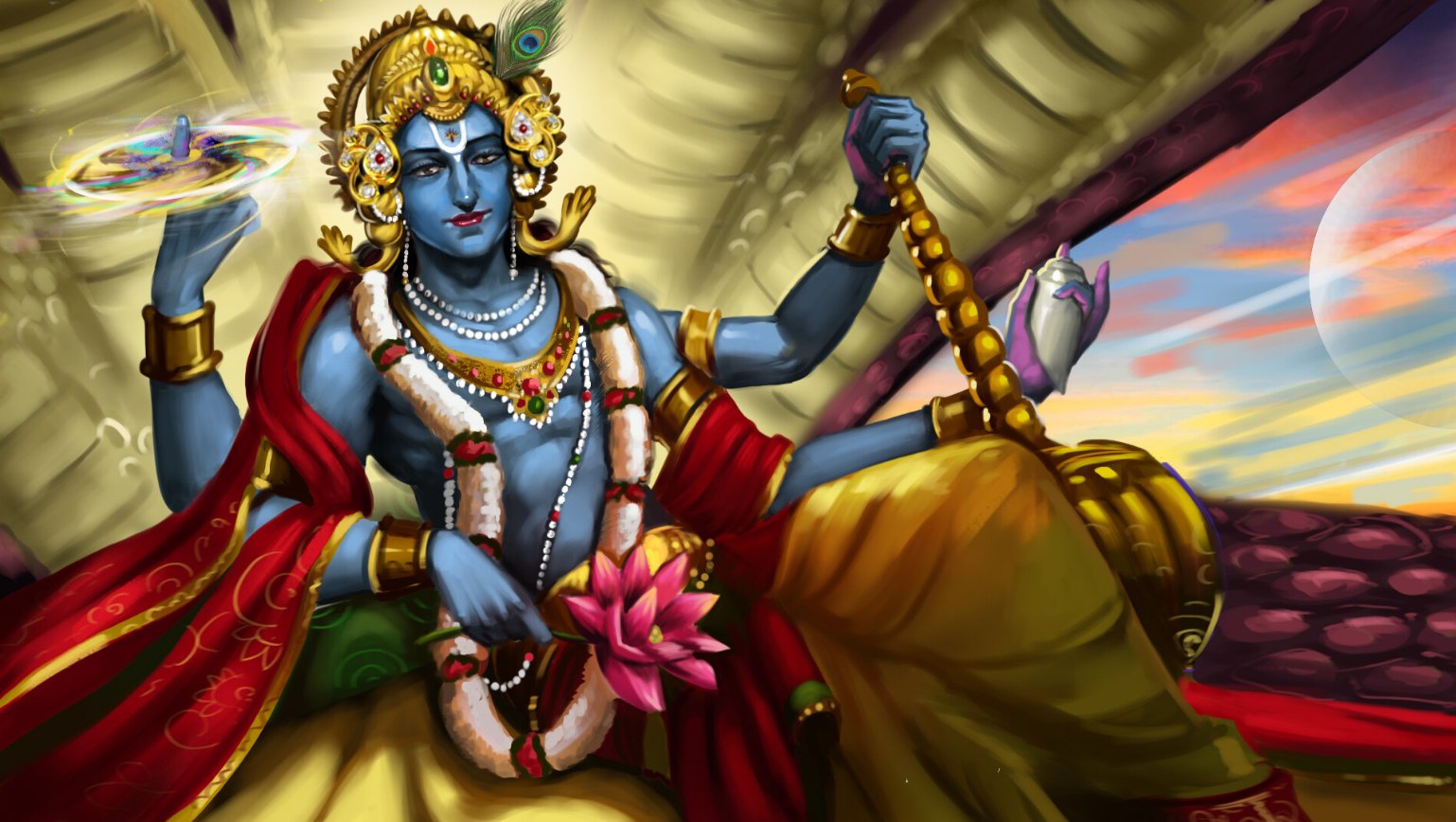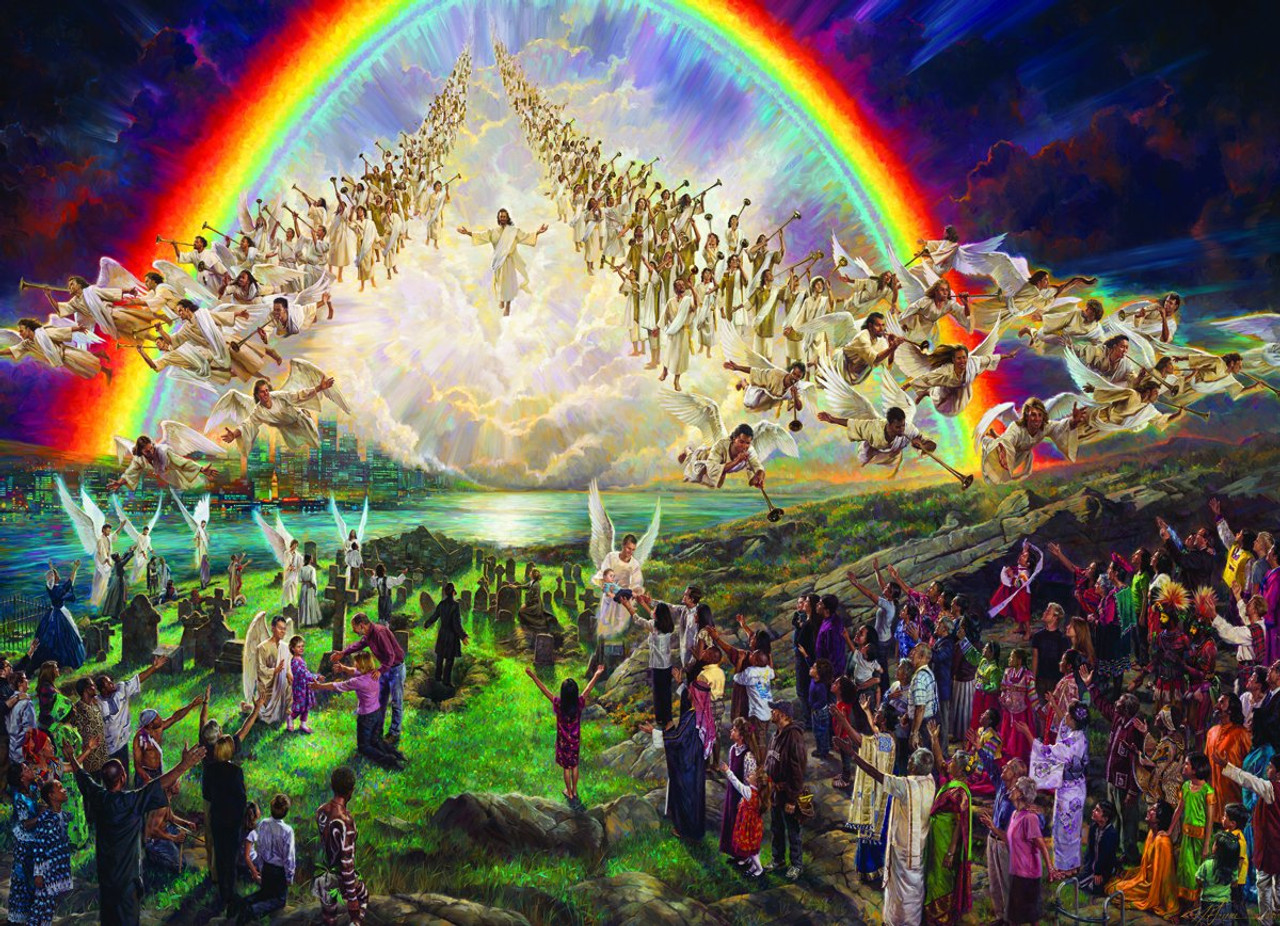

The Bhagavad Gita records the conversation between Krishna and Arjuna right before the epic battle of Kurukshetra. Although it is a part of The Mahabharata, it often is taught separately for its insights into Hindu beliefs. Krishna is the eighth human avatar of the god Vishnu, who sends down an avatar every time that the world requires such serious divine intervention that the good side could not win without his help. In this instance, the warrior Arjuna finds himself in a difficult position; to fight a war against evil, he must fight members of his own family, which would normally be a sin. Krishna must teach Arjuna how to know what to do when faced with conflicting duties. Some of the tension of the work comes from the setting; Krishna and Arjuna are literally between the two armies as they talk, while both sides wait for Arjuna to blow his horn, which will start the battle.

Hare Krsna Mantra:
- Hare Krishna Hare Krishna, Krishna Krishna, Hare Hare
- Hare Rama Hare Rama, Rama Rama, Hare Hare
Kṛṣṇa means God. We are all intimately connected with Him because He is our original father. But we have forgotten this connection. When we become interested in knowing, “What is my connection with God? What is the aim of life?”
Then we are called Kṛṣṇa conscious.
"Hare Kṛṣṇa, Hare Kṛṣṇa, Kṛṣṇa Kṛṣṇa, Hare Hare ..... Hare Rāma, Hare Rāma, Rāma Rāma, Hare Hare"
Master Imram's Hare Krishna Song
Master Imram sings Hari Krishna!
The Kriya Yoga technique, taught by Krishna to Arjuna and referred to in Gita chapters IV:29 and V:27–28, is the supreme spiritual science of yoga meditation. Secreted during the materialistic ages, this indestructible yoga was revived for modern man by Mahavatar Babaji and taught by the Gurus of Self-Realization Fellowship/Yogoda Satsanga Society of India. Babaji himself ordained Paramahansa Yogananda to spread this holy science of God-union….
Any devotee who will emulate Arjuna— the epitome of the ideal disciple—and perform his rightful duty with nonattachment, and perfect his practice of yoga meditation through a technique such as Kriya Yoga, will similarly draw the blessings and guidance of God and win the victory of Self-realization.
As God talked with Arjuna, so will He talk with you. As He lifted up the spirit and consciousness of Arjuna, so will He uplift you. As He granted Arjuna supreme spiritual vision, so will He confer enlightenment on you.
We have seen in the Bhagavad Gita the story of the soul’s journey back to God—a journey each one must make. O divine soul! like Arjuna, “Forsake this small weakheartedness of mortal consciousness. Arise!”
Before you is the royal path.
God Talks with Arjuna
Commentary on the Bhagavad Gita by Paramahansa Yogananda
Download Free PDF
The entire knowledge of the cosmos is packed into the Gita. . . . [it] has been understood and applied on all levels of human endeavour . . . .
Wherever one is on the way back to God, the Gita will shed its light on that segment of the journey.
— Paramahansa Yogananda
Bhagavad Gita 13.3
क्षेत्रज्ञं चापि मां विद्धि सर्वक्षेत्रेषु भारत ।
क्षेत्रक्षेत्रज्ञयोर्ज्ञानं यत्तज्ज्ञानं मतं मम ॥ ३ ॥
Translation:
O scion of Bharata, you should understand that I am also the knower in all bodies, and to understand this body and its knower is called knowledge. That is My opinion.
☆☆☆☆☆☆☆☆Purport☆☆☆☆☆☆☆☆
While discussing the subject of the body and the knower of the body, the soul and the Supersoul, we shall find three different topics of study: the Lord, the living entity, and matter. In every field of activities, in every body, there are two souls: the individual soul and the Supersoul.
Because the Supersoul is the plenary expansion of the Supreme Personality of Godhead, Kṛṣṇa, Kṛṣṇa says, “I am also the knower, but I am not the individual knower of the body. I am the superknower. I am present in every body as the Paramātmā, or Supersoul.”
One who studies the subject matter of the field of activity and the knower of the field very minutely, in terms of this Bhagavad-gītā, can attain to knowledge.
The Lord says, “I am the knower of the field of activities in every individual body.” The individual may be the knower of his own body, but he is not in knowledge of other bodies. The Supreme Personality of Godhead, who is present as the Supersoul in all bodies, knows everything about all bodies. He knows all the different bodies of all the various species of life.
A citizen may know everything about his patch of land, but the king knows not only his palace but all the properties possessed by the individual citizens. Similarly, one may be the proprietor of the body individually, but the Supreme Lord is the proprietor of all bodies. The king is the original proprietor of the kingdom, and the citizen is the secondary proprietor. Similarly, the Supreme Lord is the supreme proprietor of all bodies.
The body consists of the senses. The Supreme Lord is Hṛṣīkeśa, which means “the controller of the senses.” He is the original controller of the senses, just as the king is the original controller of all the activities of the state; the citizens are secondary controllers.
The Lord says, “I am also the knower.” This means that He is the superknower; the individual soul knows only his particular body. In the Vedic literature, it is stated as follows:
kṣetrāṇi hi śarīrāṇi
bījaṁ cāpi śubhāśubhe
tāni vetti sa yogātmā
tataḥ kṣetra-jña ucyate
This body is called the kṣetra, and within it dwells the owner of the body and the Supreme Lord, who knows both the body and the owner of the body. Therefore He is called the knower of all fields.
☆□☆□The distinction between the field of activities, the knower of activities, and the supreme knower of activities is described as follows. Perfect knowledge of the constitution of the body, the constitution of the individual soul, and the constitution of the Supersoul is known in terms of Vedic literature as jñāna. That is the opinion of Kṛṣṇa. To understand both the soul and the Supersoul as one yet distinct is knowledge.
One who does not understand the field of activity and the knower of activity is not in perfect knowledge. One has to understand the position of prakṛti (nature), puruṣa (the enjoyer of nature) and īśvara (the knower who dominates or controls nature and the individual soul). One should not confuse the three in their different capacities.
One should not confuse the painter, the painting and the easel. This material world, which is the field of activities, is nature, and the enjoyer of nature is the living entity, and above them both is the supreme controller, the Personality of Godhead.
It is stated in the Vedic language
(in the Śvetāśvatara Upaniṣad 1.12)
bhoktā bhogyaṁ preritāraṁ ca matvā.
sarvaṁ proktaṁ tri-vidhaṁ brahmam etat.
There are three Brahman conceptions: prakṛti is Brahman as the field of activities, and the jīva (individual soul) is also Brahman and is trying to control material nature, and the controller of both of them is also Brahman, but He is the factual controller.
In this chapter it will also be explained that out of the two knowers, one is fallible and the other is infallible. One is superior and the other is subordinate. One who understands the two knowers of the field to be one and the same contradicts the Supreme Personality of Godhead, who states here very clearly, “I am also the knower of the field of activity.” One who misunderstands a rope to be a serpent is not in knowledge.
There are different kinds of bodies, and there are different owners of the bodies. Because each individual soul has his individual capacity for lording it over material nature, there are different bodies. But the Supreme also is present in them as the controller. The word ca is significant, for it indicates the total number of bodies.
Kṛṣṇa is the Supersoul present in each and every body apart from the individual soul. And Kṛṣṇa explicitly says here that real knowledge is to know that the Supersoul [God] is the controller of both the field of activities and the finite enjoyer.
~ Bhagavad Gita, As It Is by Swami Srila Prabhupada
Swami Srila Prabhupada
When His Divine Grace A.C. Bhaktivedanta Swami Srila Prabhupada entered the port of New York City on September 17, 1965 few Americans took notice — but he was not merely another immigrant. He was on a mission to introduce the ancient teachings of Vedic India into mainstream America. Before Srila Prabhupada passed away on November 14, 1977 at the age of 81, his mission proved successful. He had founded the International Society for Krishna Consciousness (ISKCON) and saw it grow into a worldwide confederation of more than 100 temples, ashrams and cultural centers.
Srila Prabhupada was born Abhay Charan De on September 1, 1896 to a pious Hindu family in Calcutta. As a youth growing up in British-controlled India, Abhay became involved with Mahatma Gandhi’s civil disobedience movement to secure independence for his nation. It was, however, a 1922 meeting with a prominent scholar and religious leader, Srila Bhaktisiddhanta Sarasvati, which proved most influential on Abhay’s future calling. Srila Bhaktisiddhanta was a leader in the Gaudiya Vaishnava denomination, a monotheistic tradition within the broad Hindu culture, and asked Abhay to bring the teachings of Lord Krishna to the English-speaking world. Abhay became a disciple of Srila Bhaktisiddhanta in 1933, and resolved to carry out his mentor’s request. Abhay, later known by the honorific A.C. Bhaktivedanta Swami Prabhupada, spent the next 32 years preparing for his journey west.
In 1965, at the age of sixty-nine, Srila Prabhupada traveled to New York City aboard a cargo ship. The journey was treacherous, and the elderly spiritual teacher suffered two heart attacks aboard ship. Arriving in the United States with just seven dollars in Indian rupees and his translations of sacred Sanskrit texts, Srila Prabhupada began to share the timeless wisdom of Krishna consciousness. His message of peace and goodwill resonated with many young people, some of whom came forward to become serious students of the Krishna tradition. With the help of these students, Srila Prabhupada rented a small storefront on New York’s Lower East Side to use as a temple. On July 11, 1966, he officially registered his organization in the state of New York, formally founding the International Society for Krishna Consciousness.
In the eleven years that followed, Srila Prabhupada circled the globe 14 times on lecture tours, bringing the teachings of Lord Krishna to thousands of people on six continents. Men and women from all backgrounds and walks of life came forward to accept his message, and with their help, Srila Prabhupada established ISKCON centers and projects throughout the world. Under his inspiration, Krishna devotees established temples, rural communities, educational institutions, and started what would become the world’s largest vegetarian food relief program. With the desire to nourish the roots of Krishna consciousness in its home, Srila Prabhupada returned to India several times, where he sparked a revival in the Vaishnava tradition. In India, he opened dozens of temples, including large centers in the holy towns of Vrindavan and Mayapur.
Srila Prabhupada’s most significant contributions, perhaps, are his books. He authored over 70 volumes on the Krishna tradition, which are highly respected by scholars for their authority, depth, fidelity to the tradition, and clarity. Several of his works are used as textbooks in numerous college courses. His writings have been translated into 76 languages. His most prominent works include: Bhagavad-gita As It Is, the 30-volume Srimad-Bhagavatam, and the 17-volume Sri Caitanya-caritamrita.
Prabhupada's Books: Amazon | Free PDF's
Krishna as a boy
Prince Rama is the 7th Avatar of Vishnu, Hanumanji is with him.
Krishna was the 8th avataric incarnation of Vishnu, Arjuna is with him.



